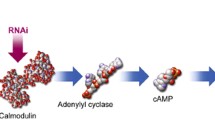Summary
Hydrostatic pressure applied to one end of a horizontalChara cell induces a polarity of cytoplasmic streaming, thus mimicking the effect of gravity. A positive hydrostatic pressure induces a more rapid streaming away from the applied pressure and a slower streaming toward the applied pressure. In contrast, a negative pressure induces a more rapid streaming toward and a slower streaming away from the applied pressure. Both the hydrostatic pressure-induced and gravity-induced polarity of cytoplasmic streaming respond identically to cell ligation, UV microbeam irradiation, external Ca2+ concentrations, osmotic pressure, neutral red, TEA Cl−, and the Ca2+ channel blockers nifedipine and LaCl3. In addition, hydrostatic pressure applied to the bottom of a vertically-oriented cell can abolish and even reverse the gravity-induced polarity of cytoplasmic streaming. These data indicate that both gravity and hydrostatic pressure act at the same point of the signal transduction chain leading to the induction of a polarity of cytoplasmic streaming and support the hypothesis that characean cells respond to gravity by sensing a gravity-induced pressure differential between the cell ends.
Similar content being viewed by others
References
Audus LJ (1979) Plant geosensors. J Exp Bot 30: 1051–1073
Björkman T (1988) Perception of gravity by plants. Adv Bot Res 15: 1–41
Bisson MA, Bartholomew D (1984) Osmoregulation or turgor regulation inChara? Plant Physiol 74: 252–255
Caspar T, Pickard BG (1989) Gravitropism in a starchless mutant ofArabidopsis. Planta 177: 185–197
Dainty J, Ginzburg BZ (1964) The reflection coefficient of plant cell membranes for certain solutes. Biochim Biophys Acta 79: 129–137
Ewart AJ (1903) On the physics and physiology of protoplasmic streaming in plants. Clarendon Press, Oxford
Fortin M-C, Poff K (1990) Temperature sensing of primary roots of maize. Plant Physiol 94: 367–369
— — (1991) Characterization of thermotropism in primary roots of maize: dependence on temperature and temperature gradient, and interaction with gravitropism. Planta 184: 410–414
Gersani M, Sachs T (1990) Perception of gravity expressed by vascular differentiation. Plant Cell Environ 13: 495–498
Hayashi T (1957) Some dynamic properties of the protoplasmic streaming inChara. Bot Mag (Tokyo) 70: 168–174
Imae Y (1985) Molecular mechanism of thermosensing in bacteria. In: Eisenbach M, Balaban M (eds) Sensing and response in microorganisms. Elsevier, New York, pp 73–81
Ingber D (1991) Integrins as mechanochemical transducers. Curr Opin Cell Biol 3: 841–848
Kamiya N (1940) Control of protoplasmic streaming. Science 92: 462–463
Kamiya N, Tazawa M (1956) Studies on water permeability of a single plant cell by means of transcellular osmosis. Protoplasma 46: 394–422
Kawamura G, Tazawa M (1980) Rapid light-induced potential change inChara cells stained with neutral red in the absence of internal Mg-ATP. Plant Cell Physiol. 21: 547–559
Kiss JZ, Sack FD (1989) Reduced gravitropic sensitivity in roots of a starch-deficient mutant ofNicotiana sylvestris. Planta 180: 123–130
—, Hertel R, Sack FD (1989) Amyloplasts are necessary for full gravitropic sensitivity in roots ofArabidopsis thaliana. Planta 177: 198–206
Moore D (1991) Perception and response to gravity in higher fungi — a critical appraisal. New Phytol 117: 3–23
Moore R (1989) Root gravitropism and cellular differentiation in wild-type and a starchless mutant ofArabidopsis thalianaAnn Bot 64: 271–277
Nobel P (1983) Biophysical plant physiology and ecology. WH Freeman, New York
Nuccitelli R (1988) Physiological electric fields can influence cell motility, growth, and polarity. Adv Cell Biol 2: 213–233
Patel N, Poo M-M (1984) Pertubation of the direction of neurite growth by pulsed and focal electric fields. J Neurosci 4: 2939–2947
Poff K, Skokut M (1977) Thermotaxis by pseudoplasmodia ofDictyostelium discoideum. Proc Natl Acad Sci USA 74: 2007–2010
Sack F (1991) Plant gravity sensing. Int Rev Cytol 127: 193–252
Schreurs WJA, Harold RL, Harold FM (1989) Chemotropism and branching as alternative responsesAchlya bisexualis to amino acids. J Gen Microbiol 135: 2519–2528
Takahashi H, Scott T (1991) Hydrotropism and its interaction with gravitropism in maize roots. Plant Physiol 96: 558–564
Takeshige K, Tazawa M (1989) Determination in the inorganic pyrophosphate level and its subcelluar localization inChara corallina. J Biol Chem 264: 3262–3266
Tazawa M (1968) Motive force of the cytoplasmic streaming inNitella. Protoplasma 65: 207–222
Wareing PF, Nasr TA (1958) Effect of gravity on growth, apical dominance and flowering in fruit trees. Nature 182: 379–380
Wayne R (1985) The contribution of calcium ions and hydrogen ions to the signal transduction chain in phytochrome-mediated fern spore germination. PhD Thesis, University of Massachusetts, Amherst, MA, USA
—, Staves MP (1991) The density of the cell sap and endoplasm ofNitellopsis andChara. Plant Cell Physiol: 32: 1137–1144
—, Tazawa M (1988) The actin cytoskeleton and polar water permeability in characean cells. Protoplasma [Suppl 2]: 116–130
— — (1990) Nature of the water channels in the internodal cells ofNitellopsis. J Membrane Biol 116: 31–39
—, Kadota A, Watanabe M, Furuya M (1991) Photomovement inDunaliella: fluence rate-response curves and action spectra. Planta 184: 515–524
—, Staves MP, Leopold AC (1990) Gravity-dependent polarity of cytoplasmic streaming inNitellopsis. Protoplasma 155: 43–57
- - - (1992) The contribution of the extracellular matrix to gravisensing in characean cells. J Cell Sci (in press)
Westing AH (1971) A case against the statoliths. In: Gorden SA, Cohen MJ (eds) Gravity and the organism. University of Chicago Press, Chicago, pp 97–101
Author information
Authors and Affiliations
Rights and permissions
About this article
Cite this article
Staves, M.P., Wayne, R. & Leopold, A.C. Hydrostatic pressure mimics gravitational pressure in characean cells. Protoplasma 168, 141–152 (1992). https://doi.org/10.1007/BF01666260
Received:
Accepted:
Issue Date:
DOI: https://doi.org/10.1007/BF01666260




